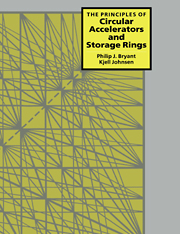Book contents
- Frontmatter
- Contents
- Foreword
- Coordinate system
- Symbols
- Useful Constants
- 1 Introduction
- 2 Basic concepts and constant-gradient focusing
- 3 Alternating-gradient focusing
- 4 Parameterisation of the transverse motion
- 5 Imperfections and resonances
- 6 Chromaticity
- 7 Longitudinal beam dynamics
- 8 Image and space-charge forces (transverse)
- 9 Coherent instabilities
- 10 Radiating particles
- 11 Diagnosis and compensation
- 12 Special aspects of circular colliders
- Appendix A Transverse particle motion in an accelerator
- Appendix B Accelerator magnets
- Appendix C Closed orbits
- Appendix D Phase equation
- Appendix E Vlasov equation
- References
- Index
6 - Chromaticity
Published online by Cambridge University Press: 11 November 2009
- Frontmatter
- Contents
- Foreword
- Coordinate system
- Symbols
- Useful Constants
- 1 Introduction
- 2 Basic concepts and constant-gradient focusing
- 3 Alternating-gradient focusing
- 4 Parameterisation of the transverse motion
- 5 Imperfections and resonances
- 6 Chromaticity
- 7 Longitudinal beam dynamics
- 8 Image and space-charge forces (transverse)
- 9 Coherent instabilities
- 10 Radiating particles
- 11 Diagnosis and compensation
- 12 Special aspects of circular colliders
- Appendix A Transverse particle motion in an accelerator
- Appendix B Accelerator magnets
- Appendix C Closed orbits
- Appendix D Phase equation
- Appendix E Vlasov equation
- References
- Index
Summary
CHROMATIC EFFECTS
Chromatic effects are caused by the momentum dependence of the focal properties of lattice elements. The momentum of a particle is closely analogous to the frequency of light in classical optics and it is for this reason that the name chromaticity has been adopted (Gk. chroma colour). Figure 6.1 illustrates the effect of the momentum dependence of the focal length of a lens, first for a beam in a dispersion-free region, which is the normal case in classical optics and secondly for a beam with finite dispersion, which is the normal case in the arcs of an accelerator. The differential bending in dipoles gives rise to the dispersion function D(s), which is also strictly a chromatic effect, but since the dispersion function is well understood and readily calculated by optics programs, it is not usually included under the title of chromaticity.
Optical systems can be made achromatic by combining lenses made from different glasses, whose refractive indices behave differently with wavelength, but the focal strength of a magnetic lens always varies with momentum according to the same law, so that accelerators have no equivalent of a ‘different glass’. Instead, the accelerator designer uses sextupoles, set in regions with finite dispersion. This can be rather complex and far from ideal. The complexity arises because errors that occur in a dispersion-free region, as shown in Figure 6.1(a), cannot be corrected locally.
- Type
- Chapter
- Information
- The Principles of Circular Accelerators and Storage Rings , pp. 120 - 138Publisher: Cambridge University PressPrint publication year: 1993



